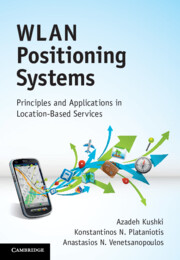3 - Positioning techniques
from Part I - History and applications
Published online by Cambridge University Press: 05 February 2012
Summary
In the previous chapters, we discussed the history and application of modern positioning systems that enable the delivery of location-based services (LBS). In this chapter, we shift our attention to the fundamental positioning principles used in these systems. We begin this chapter by presenting the location stack, a model of location-aware systems, and identify the focus of this book (Section 3.1). We then proceed to discuss the most commonly used techniques for computing the position of mobile receivers. Similar to the techniques used in celestial navigation, modern positioning systems often employ a set of references with known locations for position computation. In this chapter, we discuss different positioning methods, differentiated by the type of references and signal measurements used (Sections 3.2 to 3.4). In addition to these techniques, which generally employ wireless signals, we will also briefly review dead reckoning (Section 3.6) and computer-based positioning (Section 3.7) methods. These two techniques employ modalities complementary to wireless measurements and as such provide a promising direction of development for hybrid positioning systems that employ multiple measurements to improve the accuracy and reliability of positioning. Finally, we conclude the chapter by discussing the advantages and disadvantages of each positioning method (Section 3.8).
The location stack
To position this book within the wealth of information available on positioning systems used in LBS, we review a model of location-aware systems proposed by Hightower et al. [35].
- Type
- Chapter
- Information
- WLAN Positioning SystemsPrinciples and Applications in Location-Based Services, pp. 30 - 41Publisher: Cambridge University PressPrint publication year: 2012



